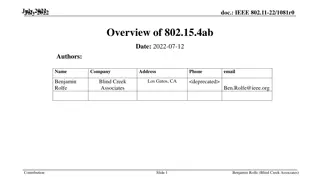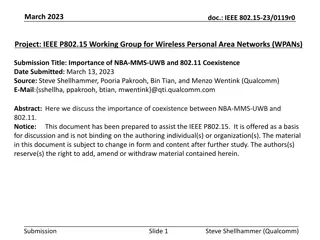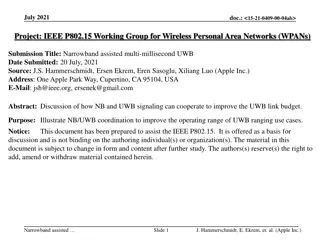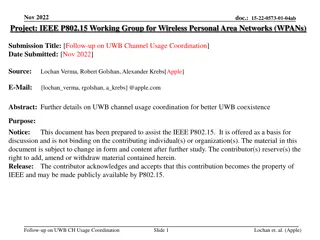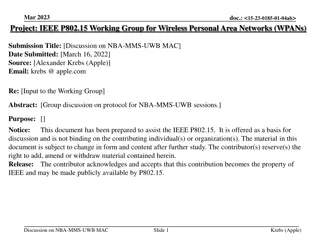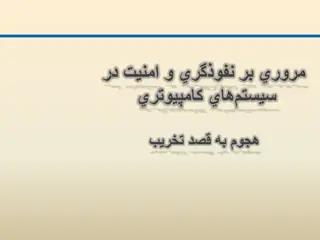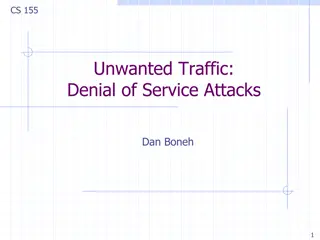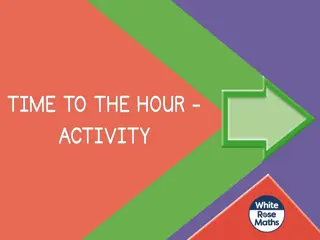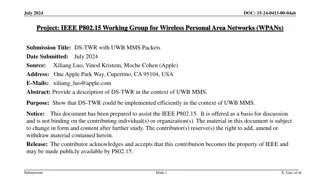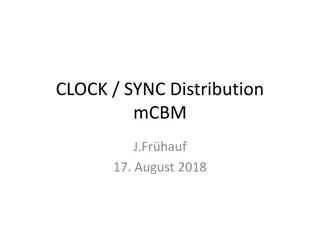Clock-Related Attacks on UWB Ranging: More Insights
Presentation of Mix-Down (MD) and Stretch-and-Advance (S&A) attacks aiming to raise awareness of clock-related security issues in UWB transceivers. The document discusses the challenges, proposed solutions, and references for improving security aspects in wireless personal area networks.
Download Presentation

Please find below an Image/Link to download the presentation.
The content on the website is provided AS IS for your information and personal use only. It may not be sold, licensed, or shared on other websites without obtaining consent from the author.If you encounter any issues during the download, it is possible that the publisher has removed the file from their server.
You are allowed to download the files provided on this website for personal or commercial use, subject to the condition that they are used lawfully. All files are the property of their respective owners.
The content on the website is provided AS IS for your information and personal use only. It may not be sold, licensed, or shared on other websites without obtaining consent from the author.
E N D
Presentation Transcript
May 2023 doc.: 15-23-0274-00-04ab Project: IEEE P802.15 Working Group for Wireless Personal Area Networks (WPANs) Submission Title: More on clock-related attacks against UWB ranging Date Submitted: 17 May 2023 Source: Claudio Anliker, Giovanni Camurati, Srdjan Capkun (ETH Zurich) Address: Universit tsstrasse 6, 8092 Z rich, Switzerland E-Mail: claudio.anliker@inf.ethz.ch Abstract: Presentation of Mix-Down (MD) and Stretch-and-Advance (S&A), two attacks related to device clocks of UWB transceivers. Purpose: Raising awareness for security issues Notice: This document has been prepared to assist the IEEE P802.15. It is offered as a basis for discussion and is not binding on the contributing individual(s) or organization(s). The material in this document is subject to change in form and content after further study. The contributor(s) reserve(s) the right to add, amend or withdraw material contained herein. Release: The contributor acknowledges and accepts that this contribution becomes the property of IEEE and may be made publicly available by P802.15. Submission 1 C.Anliker, G. Camurati, and S. Capkun
May 2023 doc.: 15-23-0274-00-04ab PAR Objective Safeguards so that the high throughput data use cases will not cause significant disruption to low duty-cycle ranging use cases Interference mitigation techniques to support higher density and higher traffic use cases Other coexistence improvement Backward compatibility with enhanced ranging capable devices (ERDEVs) Improved link budget and/or reduced air-time Additional channels and operating frequencies Improvements to accuracy / precision / reliability and interoperability for high-integrity ranging Proposed Solution (how addressed) Describes challenges related to clock frequency offsets in combination with multi- millisecond frames. Reduced complexity and power consumption Hybrid operation with narrowband signaling to assist UWB Describes risks of an NB-based offset estimation. Enhanced native discovery and connection setup mechanisms Sensing capabilities to support presence detection and environment mapping Low-power low-latency streaming Higher data-rate streaming allowing at least 50 Mbit/s of throughput Support for peer-to-peer, peer-to-multi-peer, and station-to- infrastructure protocols Infrastructure synchronization mechanisms Submission 2 C.Anliker, G. Camurati, and S. Capkun
May 2023 doc.: 15-23-0274-00-04ab References This is a follow-up to: 15-22-0410-00-04ab: "NBA-MMS UWB - Security Considerations" (https://mentor.ieee.org/802.15/dcn/22/15-22-0410-00-04ab-nba-mms-uwb-security- considerations.pptx) Further documents: 15-22-0499-00-04ab: RMARKERs in Mixed MMS for Ranging Integrity (https://mentor.ieee.org/802.15/dcn/22/15-22-0499-00-04ab-rmarkers-in-mixed-mms-for- ranging-integrity.pptx) 15-23-0100-02-04ab: NBA-UWB Technical Framework (for Draft0) (https://mentor.ieee.org/802.15/dcn/23/15-23-0100-02-04ab-nba-uwb-technical- framework-for-draft0.docx) Preprint of our paper: https://arxiv.org/abs/2305.09433 Submission 3 C.Anliker, G. Camurati, and S. Capkun
May 2023 doc.: 15-23-0274-00-04ab The Mix-Down (MD) Attack against SS-TWR Submission 4 C.Anliker, G. Camurati, and S. Capkun
May 2023 doc.: 15-23-0274-00-04ab MD: Introduction In SS-TWR, the initiator compensates for the clock frequency offset ? to increase ranging accuracy: ????=1 ?????? 1 ? ?????? 2 The initiator estimates ? based on the carrier frequency offset (CFO) of the received signal. In the Mix-Down attack, we change the carrier frequency ?? of the responder s message to ?? < ??. INIT RESP ?? ?? Submission Slide 5 C.Anliker, G. Camurati, and S. Capkun
May 2023 doc.: 15-23-0274-00-04ab MD: Distance reduction The ToF changes by: ???= ? 2?????? ?: clock frequency offset [ppm] between attacker and responder. ??????: reply time of the responder, unchangeable for the attacker. Our experiments have shown that ? 25ppm is realistic. Larger ? caused RX failures (due to sampling adjustments in the receiver). Submission Slide 6 C.Anliker, G. Camurati, and S. Capkun
May 2023 doc.: 15-23-0274-00-04ab MD: Example for ?= 25ppm Submission Slide 7 C.Anliker, G. Camurati, and S. Capkun
May 2023 doc.: 15-23-0274-00-04ab The Stretch-and-Advance (S&A) Attack against NBA-MMS-UWB (4ab) Submission 8 C.Anliker, G. Camurati, and S. Capkun
May 2023 doc.: 15-23-0274-00-04ab S&A: Starting Point RSFs: estimate ToA of ranging message RIFs: for ranging integrity NB: used to transmit data and estimate clock frequency offset RMARKER TX NB RSF RIF RX NB RSF RIF ToF ? Submission Slide 9 C.Anliker, G. Camurati, and S. Capkun
May 2023 doc.: 15-23-0274-00-04ab S&A: Attack RMARKER TX NB RSF RIF Attacker NB RSF RIF 1 3 2 RX NB NB RSF RSF RIF RIF ToF reduce carrier frequency (MD) 3 stretch and replay RIFs stretch and advance RSFs 1 2 Submission Slide 10 C.Anliker, G. Camurati, and S. Capkun
May 2023 doc.: 15-23-0274-00-04ab S&A: Distance reduction RMARKER ??????? ? ... Received by the attacker: RSF RIF ... RSF RIF Transmitted by the attacker: ??? The distance reduction is equal to ???= ?? ? [ppm]: clock drift between the attacker and the transmitter ? [sec]: time interval between the RMARKER and ??????? ???????: timestamp after which the attacker can learn and replay pulses. Here, the attacker can learn the entire RIF. Submission Slide 11 C.Anliker, G. Camurati, and S. Capkun
May 2023 doc.: 15-23-0274-00-04ab S&A: Exploiting RIF error tolerance RMARKER ??????? ? Received by the attacker: RSF RIF RSF RIF Transmitted by the attacker: unknown pulses Example: shift the message such that 4 out of 8 RIFs are unpredictable. ? has increased by 4??. The attacker still transmits 4 RIFs correctly (after ???????). The receiver might consider this message to be authentic, if the "overall correctness" of the RIFs is high enough. Submission Slide 12 C.Anliker, G. Camurati, and S. Capkun
May 2023 doc.: 15-23-0274-00-04ab S&A: Example with ?= 40???: Deterministic reductions (without exploiting RIF error tolerance): 1 RSF: ???= 1?? 40??? = 40?? 12? 8 RSF: ???= 8?? 40??? = 320?? 96? If the receiver accepts ? corrupt/missing RIF, the possible reduction grows by ???= 12? ?. Submission Slide 13 C.Anliker, G. Camurati, and S. Capkun
May 2023 doc.: 15-23-0274-00-04ab S&A: Countermeasures I Status Quo: The draft envisions two additional RMARKERS per RIF. These RMARKERS may help against S&A if used correctly: If the ToA is defined by the average of RIF-RMARKER 1 and RIF- RMARKER Y , then the countermeasure mitigates the attack. If the ToA equals to the timestamp of the RSF-RMARKER, then the additional RIF-RMARKERs do not mitigate the attack. Currently, the draft lacks both motivation and recommendation. Submission Slide 14 C.Anliker, G. Camurati, and S. Capkun
May 2023 doc.: 15-23-0274-00-04ab S&A: Countermeasures II The effect of the countermeasure depends on the receiver s error tolerance in the RIFs. Focal question: Does the receiver accept a ranging message in which the leading half (or more) of the RIF pulses are missing (or guessed randomly)? If no: either measure prevents S&A completely. If yes: smaller distance reductions remain possible (still > 10?). Submission Slide 15 C.Anliker, G. Camurati, and S. Capkun
May 2023 doc.: 15-23-0274-00-04ab Take-Aways Mix-Down attack: Only affects SS-TWR Easy to execute, demonstrated on 4z-compliant devices. SS-TWR (with real-time clock drift compensation) is not suited for secure ranging. This should be pointed out in the standard. Stretch-and-Advance: Irrelevant for mandatory 4z configurations But: impact on NBA-MMS-UWB in 4ab (potential reductions >96m) SS-TWR and DS-TWR are equally affected. Standard should motivate and recommend a countermeasure. Generally speaking, the standard should provide guidance and recommendations to prevent known security issues. Submission Slide 16 C.Anliker, G. Camurati, and S. Capkun
May 2023 doc.: 15-23-0274-00-04ab APPENDIX Submission Slide 17 C.Anliker, G. Camurati, and S. Capkun
May 2023 doc.: 15-23-0274-00-04ab S&A: Countermeasures II Idea 1: Define ToA as ????= ????+ ? 1 ? , where ? is the measured clock frequency offset and ? is the delay of the middle of the RIF w.r.t the RSF-RMARKER ???? no change ???? ? 1 ? no attack (? = 0???): RSF RIF attack (? < 0???): RSF RIF unknown pulses Submission Slide 18 C.Anliker, G. Camurati, and S. Capkun





